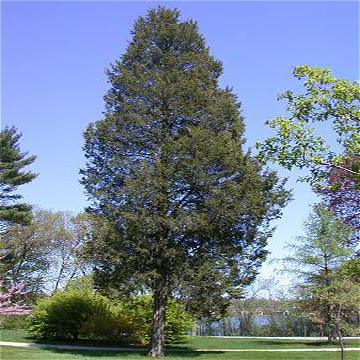

Juniperus virginiana - (image 1 of 5)
Taxonomy
Family: Cupressaceae
Habitat
Pastures and abandoned fields, rocky ridges and on dry sandy soils.
Associates
Distribution
Found in every state east of the 100th meridian.
Morphology
Erect tree to 50' high and 20' wide. Leaves dark bluish-green; some scale-like, 2mm long, pointed, appressed-imbricated, successive pairs overlapping; needle-like leaves 12mm long, often on the same branch with scale-like leaves. Bark thin, fibrous, gray to red-brown, exfoliating in long strips. Flowers dioecious; staminate flowers yellow, causing male trees to take on a yellow-brown coloration when releasing pollen; pistillate flowers green. Fruit a berry-like cone, dark blue with a waxy bloom, containing 1 to 2 seeds, ripening in the 1st year.
Notes
Flowers from late February to March
Wetland indicator: Facultative Upland
The wood is aromatic, reddish, resistant to decay. Pyramidal when young and slightly pendulous in old age. A good landscape tree. Considered a weed in some states; populations of red cedar have increased as a result of fire-suppression in many areas, particularly the west. Population studies suggest that hybrids occur between this species, J. horizontalis, and J. scopulorum (Rocky Mountain Juniper).
References
Curtis, J. T. 1959. Vegetation of Wisconsin.
Madison, Wisconsin: University of Wisconsin Press.
Dirr, Michael A. 1998. Manual of Woody Landscape Plants:
Their Identification, Ornamental Characteristics, Culture, Propagation and Uses.
5th ed. Champaign, Illinois: Stipes Publishing L.L.C.
Lawson, Edwin R. 1990. Juniperus virginiana L. Eastern Redcedar.
In R.M. Burns and B.H. Honkala (eds.), Silvics of North America, Vol. 1, Conifers, U.S.D.A.
For. Serv. Agric. Handbk. 654, Washington, D.C.
Farrar, J. L. 1995. Trees of the Northern United States and Canada.
Ames, Iowa: Iowa State University Press
Swink, F. and G. Wilhelm. 1994. Plants of the Chicago Region.
Indiana Academy of Science. The Morton Arboretum. Lisle, Illinois.
|
Michael Hough © 2005 |